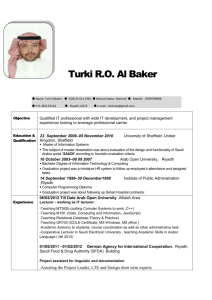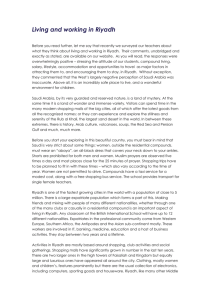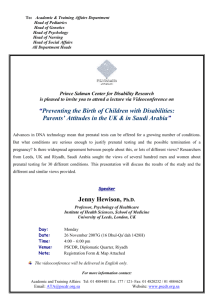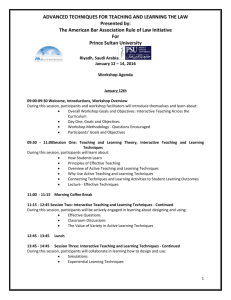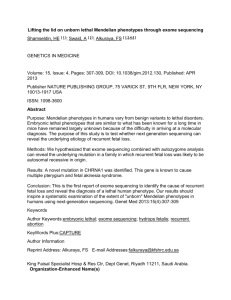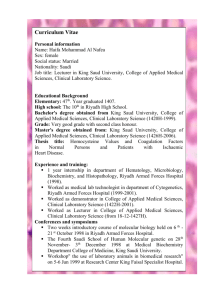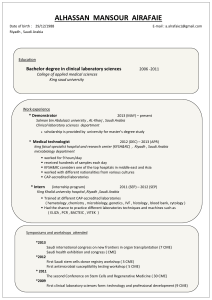City Expanding to The Desert Horizon: Riyadh's problem of
advertisement
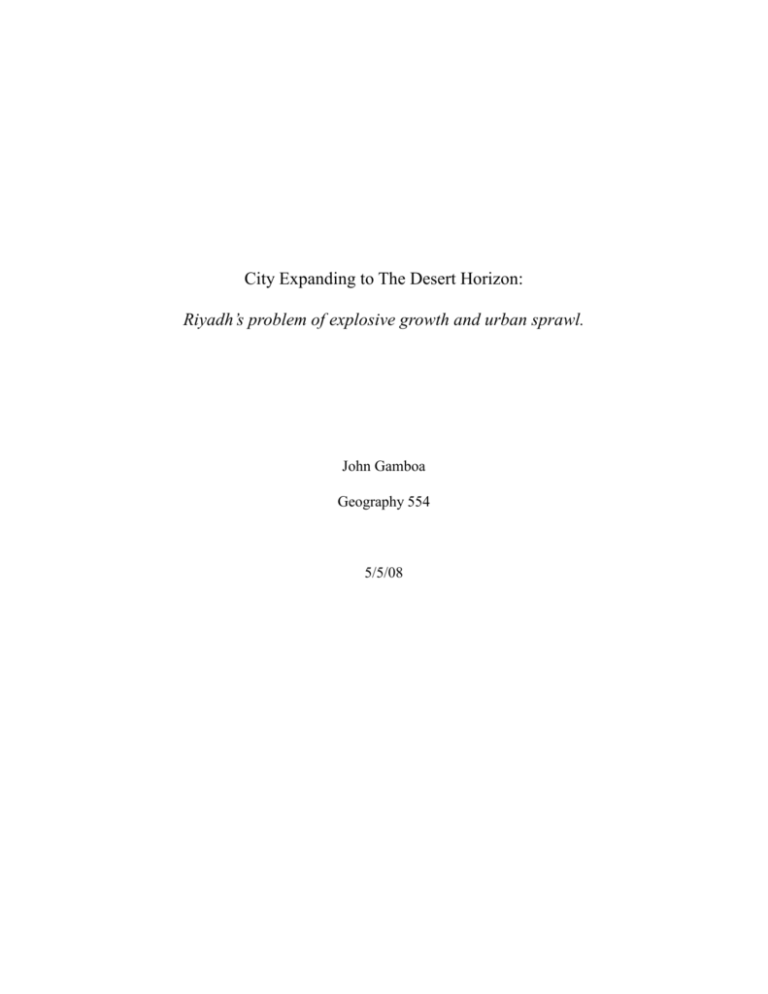
City Expanding to The Desert Horizon: Riyadh’s problem of explosive growth and urban sprawl. John Gamboa Geography 554 5/5/08 Riyadh and urban sprawl: Riyadh’s explosive growth in the last hundred years bore fruit for the nation of Saudi Arabia. Some of it has been sweet, and others have been bitter, or still waiting to ripe. The rapid growth of the capital city has created problems of sustainable and equal growth. In the last fifteen years in particular, the Kingdom of Saud has much to facilitate the oil-based growth of its city. Governmental decrees by the Saudi royalty have helped in more than one way to create issues of sprawling, lop-sided development and a general lack of sustainable planning to accommodate the city’s growth. One of the facilitating factors to the city’s growth is the use of no-interest loans. The no-interest loan, have enabled countless businesses and global firms to expand and develop as far as needed to make Riyadh an important capital city (Al-Hemaidi 182). The Saudi government saw that low- to no-interest loans allowed for even small developing firms to expand as far as necessary to help the city’s growth from a 1 square kilometer medina to a 3,000 square kilometer metropolitan zone in a little under a 100 years (AlGabbani 376). The traditional urban form of Riyadh as a walled Medina The city’s focus on building upward, not outward, to alleviate pressures of an ever-expanding urban area was pushed in the late 1990s and attempted to change its building focus. While such a plan resulted in the construction of the Kingdom Center in the city center, there is no evidence as of yet that shows the current expansion of the city has yielded a decelerated growth period (Jehl). The Kingdom Center may be in the densely populated core of Riyadh, but anything beyond this small commercial zone is significantly less dense. (Al-Gabbani 380). Much of these problems that have been associated with the growth of Riyadh are related to the Saudi government. The oil boom that started in the 1970s also helped lead the city into its modern state. In order to begin the establishment of Riyadh as functioning capital city, the government of Saudi Arabia set forth different phases of development necessary to the growth of the city. The troubling and tortuous establishment of the city over a thirty year period from small tribal enclave to nation’s capital brought services issues that are still seen by many today. In its development phase, the city sprawled into income-based inequities where services were unable to reach a large portion of the city’s residents. The growth of the city beyond the city’s original walled-medina left an infinite amount of space for growth, that in turn created several barriers for developing proper services for its residents (Al-Hemaidi 182). The oil boom period of the city made millions of dollars available to the government to allow for continued development. The expansion of much-needed services became part of the plan (Mubarak 2004, 247). Part of the problem with the development of necessary public services was their lack of communication with other ministries. Public services for road construction were often uncoordinated with residential construction and created heavy traffic and transportation problems. The lack of coordination with services in the development of the sprawling city was so bad that in 1985, the government halted all further construction until development could be under control, to a certain extent (Murbarak). The two year halt resulted in a reorganization of construction and also included the planning and definition of the city’s boundaries. During Riyadh’s expansion outwards, city agencies provided poor planning in the leasing and planning of land . The city outskirts of the 1970s is about the half the radial distance from the city center compared to the boundaries of today (Garba 600). Agriculture and large land plots also proved somewhat troublesome to expansion (601). The Ministry of Agriculture contributed to the sprawl of its city by setting aside inadequate land-sizes for agricultural use. Had the lots been large enough, there would be no encroachment by surrounding development of urban protection zones (602). When the land sizes are not large enough, it is difficult to maintain the character of agriculture, especially when surrounded by expanding urban development. Many of the city’s planners felt that the best way to create a cohesive and unifying identity of the city was to place limits on its physical area. With the expansive growth of the city, the reliance on automobiles created an unfriendly pedestrian environment. The sporadic development of the city during the initial oil boom years of the 1970s and 1980s resulted in the scattershot development of residential and business enclaves that were either accessible only be car or its surrounding community (Murbarak 1995, 567). Part of Riyadh’s second phase of development is the focus on limiting the barriers associated with its massive roadway system. The sprawling landscape in Riyadh’s city limits Increasing pedestrian space in regions like the Olayya-Batha Corridor will create walkable zones that are both functional and pleasing to the eye, and also give its residents a cohesive feel and sense of communities that were often solely connected to the placements of area mosques (RDA). By limiting growth in the city boundaries, particularly in the 1985 freeze, it allowed for the services to keep up to the demand, and allowed for services to become established to reduce future costs. The city of Riyadh hopes that by connecting ill-developed services, roads and walking space, that the city can unify under a single city culture rather than the fragmented enclave style that has been rooted in Arab culture for hundreds of years. Part of the problem that Riyadh, like many other cities in the Middle East and Northern Africa (MENA), is the struggle between the modern, globalized city and the traditional Muslim ideals of the community (Struyk 145) . Riyadh constantly wrestles with the belief that in the Muslim world, “there is not even a city with defined powers, limits and function, but only an assemblage of neighborhoods, mostly defined by family, tribal, ethnic or religious criteria…appointed by the sovereign” (Struyk). Riyadh is delivered a particular dilemma as the services and culture associated with the unplanned urban area lacks basic needs of water and power. Because of the planned nature of Riyadh’s location as the nation’s capital, the construction of the city was not necessarily based around large amounts of natural resources such as water (Garba 594). While the construction of these communities were done in a haphazard manner, it created small pockets of communities in the city. The Western idea of an autonomous community was quite foreign to Arabs in the state-building of Saudi Arabia. But the seemingly-foreign concept of central government services to the people who lived Riyadh’s outskirts are faced with the need to associate their traditional lifestyle with necessity of government-supplied services for survival (Al-Hemaidi 200). The traditionally-built leapfrog communities of Riyadh, known as hilal, were the first to expand greatly beyond the medina of the old city in the 20th Century. These communities became the transitional zones of moving from the tribal form to the modern city. The mud-style compounds of the hilal were the bastion of the Arab middle class until the 1950s when importation of foreign goods became the norm that allowed fore the use of brick house construction (Al-Hathloul 610). Nonetheless, the growing problem of sprawl, and the blight associated with it is the prevalence of employer-owned housing projects within the city of Riyadh. With an unprecedented amount of foreign workers in the city of Riyadh (some estimates are upwards of 1.3 million in a city of 4.5 million), the culture of the city becomes segregated and divided along lines of origin and income (Al-Hemaidi 184). In the city of Riyadh, foreign workers are often paid significantly less than their Saudi counterparts. Due to the differences, most of the single family dwellings in the Riyadh are relegated to the middle class Saudi, leaving the middle class foreign workers to lesser-quality housing. Less than 1 percent of the housing for foreign workers is resident owned, as opposed to the 56 percent for Saudi nationals, as of 2004. Also, 24 percent of the housing that the workers live in are owned by their employer. But part of the discontinuity of the urban form of Riyadh is the living preferences of the foreign workers (Al-Gabbani 380). While many of residents of Riyadh enjoyed the living styles of detached single family dwellings, many of the foreign workers would rather live in densely-populated apartment complexes. The clustering of foreign workers is similar to the clustering of many other foreign-born groups of people in other cities. However, this contrast in living arrangements, at least during the 1980s, it seemed to strictly adhere to a contrast of Arabs to foreigners (Al-Hemaidi 183). The population of people who had come to make Riyadh better is essentially subjugated to their working role in the local communities, as they rarely are able to take part in the social activities around the city. This contributes to the sprawling of the city as a place full of specific zones and communities that have trouble communicating with the outside environments. While more recently the balance has shifted, the foreign workers within the city still continue to be placed and isolated in other parts of the city. Population in Riyadh by residency Another reason for the placement and segregation of the foreign workers was the inherent problem of placing apartment complexes near the single family dwellings, whether they are traditional inner-courtyard homes or modern villas. The proximity of multiple-story complexes to these homes creates social and religious conflicts of privacy widely practiced in the MENA (Garba 594). So, the impeding structures were required to be built in zones where the conflict with private space was minimal or non-existent. This forced a push away from the local Saudis living in Riyadh. While the foreign workers in Riyadh are often relegated to apartment complexes (Garba) during the city’s growth period, low income Saudis experienced similar treatment that created a lop-sided developmental pattern. When the city was giving plots of land away, the low-income families, which were often large, were not adequately allocated land in relation to their high-income, yet smaller in size, counterparts. The lands granted by the government also created zones for each income level, creating a discontinuity in the community framework that was not seen during the Madina stage of the pre-modern development (Struyk 150). The few areas of Riyadh that are in disrepair, which are home to the low income population, were unceremoniously sliced through during the boom period to pave roads (Al-Mosaind 264). As a result, the former cohesive fabric of the city’s ancient form was erased, fragmented the clustered neighborhoods into an ever-sprawling environment. The past can draw similar comparisons to urban areas in the United States where gated, overplanned communities attempt to remove themselves completely from the surrounding urban environment, yet still depend on the services on the outside for resources and services like food, gas and electricity. Part of the contribution to the sprawling of Riyadh was the importation of the foreign-inspired single dwelling “villa” style (Struyk 142). The initial introduction of the villa form was met with little resistance by the city’s residents in the time of its original introduction by the Saudi government’s housing subsidy some 30 years ago. However, after several years, residents in Riyadh discovered that the previous introversion of open space in the form of private courtyards was non-existent by the placement of the open space on the outside of the dwelling (144). As a result, the space, originally designed for use by families for leisure activities, became underused as it faced the social conflicts of the nation’s history of fundamental Islam. After several studies were conducted, less than 10 percent of villa residents used the open space surrounding their house for activities (146). The space became and dead buffer zone, leaving the area between homes to create unnecessary, blighted space. The few residents who used their individual villa space made it possible by placing barriers and obstructions so that neighbors cannot peek inside to the space. While the villa yard offers more space than the introverted design of the inner courtyard, it became useless space that drives the land use and city size beyond unnecessary bounds (Al-Gabbani 381). Had the Saudi government realized that the space in the villas would not be used, the gridiron design planned out for the villa suburbs could have reduced space and distance from surrounding communities. Al-Malaz suburb of Riyadh. Planned with villas and grids in mind. The near 40-mile span of the city of Riyadh would not be possible without the construction of roadways to access them on (Al-Hathloul 615). However, as a result of poor planning in the First Phase of development for Riyadh, the endless distance of the city also yielded highway congestion in commercial nodes on a level not previously seen in MENA cities. The construction of low-density single family dwelling, residential and commercial zones and areas impossible to reach by a pedestrian creates large gaps in the use of land and distances the population much further than necessary (Mubarak 2004, 580). The average resident of Riyadh makes, on average, 4.90 trips in a automobile on any given day, a number very high for a MENA city (Al-Mosaind 264). Much of the travel in an automobile is for shopping and work, both activities not normally attributed to the traditional MENA city of requiring distance traveling for these activities. With the increase in zoning and shopping center plans, the average resident must rely on access to a vehicle (Al-Mosaind). However, given the distance and social laws that prohibit women to drive, travels that would have previously been made by women on foot require either a male relative, or husband to make trips. The possibilities can be much worse, given that women remain largely incapable of taking part in the local community during daylight hours as it is impossible for women to make trips around the city for necessary errands. One proposed idea to alleviate the negative psychological effects of traffic congestion by King Saud University was to increase the cost of gasoline for its residents. Because ease and accessibility of oil, given it as Saudi Arabia’s main export, the university feels that low gas prices affect the use of vehicles. A proposed increase in fuel prices would cut consumption and reduce the frequency of trips (Al-Mosaind ). However, it still remains that Saudi Arabia is among one of a handful of nations with gas prices that do not break the $1 per gallon mark as the culture of the car has become fully rooted into the lifestyle of the average resident of Riyadh. While the problems facing Riyadh are still being managed and tackled by the city’s municipalities, many changes in the infrastructure and use of land can help change and alleviate the problems associated with the city’s sprawl. However, the problems of zoning and segregation may take several more generations before steps can be made to equalize and the nation and create better environments for all of its residents to enjoy and take part in. References: Al-Gabbani, Mohammed. "Population Density Pattern and Change in the City of Riyadh, Saudi Arabia ." GeoJournal 24(1991): 375-386. Al-Hemaidi, Waleed Kassab . "The metamorphosis of the urban fabric in an ArabMuslim City: Riyadh, Saudi Arabia." Riyadh Development Authority 16(2001): 179-201. Al-Hathloul, S. "Urban growth management - The Saudi experience." Habitat International 28(2004): 609-623. Al-Mosaind, Musaad. "Freeway traffic congestion in Riyadh, Saudi Arabia: attitudes and policy implications." Journal of Transport Geography 6(1998): 263-272. "Comprehensive Development Plan for Olaya-Batha Corridor." Riyadh Development Authority (2005): 1-25. Garba, Shaibu Bala. "Managing urban growth and development in the Riyadh metropolitan area." Habitat International 28(2004): 593-608. Jehl, Douglas. " Riyadh Journal; Rival Princes Ease Desert City's Horizon Skyward." New York Times 06 Apr 1999: http://query.nytimes.com/gst/fullpage.html?res=9D06E7DD1E39F935A35757C0A96F95 8260. Mubarak, F. A.. "Urban growth boundary policy and residential suburbanization: Riyadh, Saudi Arabia." Habitat International 28(2004): 567-591. Mubarak, F. A. (1995). The role of state in shaping urban forms. In S. Al-Hathloul, & N. Edadan (Eds.), Urban development in Saudi Arabia: Challenges and opportunities (pp. 247–285). Riyadh: Dar Al-Sahan. Struyk, Raymond J.. "Housing Policy Issues In A Rich Country With High Population Growth: The Case of Riyadh, Saudi Arabia." Review of Urban and Regional Development Studies 17(2005): 140-163.

